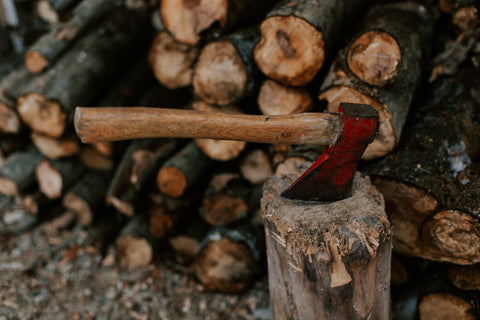Falling leaves and cooler temps mean it's time to append the wood pile. The quality and heat produced by your fires will be greatly enhanced with the right species of wood that's been properly cut, split and stacked. Whether you buy firewood from a dealer or harvest it yourself, consider these basic rules of thumb from the hearth experts at Forge & Flame.
The Right Wood
Dense woods from broadleaf species like oak, ash, maple and hickory are the best for burning. When compared to lighter conifer woods like pine, dense woods provide longer-lasting coals, produce less smoke and sparks. Make sure your wood has been seasoned properly, meaning it has air dried for at least one season after being cut, split and stacked.
Read more about finding the best wood fuel species for your needs here.
Cutting and Splitting Firewood
Consider the size of your firebox when cutting wood, so it will fit. As a rule of thumb, log lengths of 16- to 18-inches will fit in most stoves and fireplaces.
Splitting opens the log and exposes the wood to air, helping it dry. Split firewood is also easier to handle and fits into fireplaces and stoves better than un-split logs. Logs can be split by hand using axes, mauls and wedges. If you burn a lot of wood each season and harvest it yourself, consider investing in a motorized wood splitter.

How to Stack and Store Firewood
Wood that has been piled in a heap won’t burn well. The key is stack it off the ground and provide air circulation so it can dry naturally. Keep the bottom layer from contacting the ground by stacking the wood on a base, like cinder blocks. Crisscrossing the layers of wood will create spaces for air. A tarp can be draped over wood stacks during wet weather, but remove it when it’s sunny to avoid moisture build-up and promote drying.
Investing the Right Wood Stove
In addition to using wood that has been properly cut, split and stacked, having the right wood stove or insert can make all the difference.
The most efficient wood-burning units are those that are EPA-certified and outfitted with 21st Century technology. It's best to choose a wood-burning product from an established brand like Quadra-Fire or Vermont Castings. One load of wood can burn and produce heat for many hours, meaning you make less trips to the wood pile. Because they burn so efficiently, outside air particulate emissions are very low, and there is less ash for you to cleanup. Well worth the investment, you’ll enjoy warmth, ambiance and comfort and warmth for many years.






